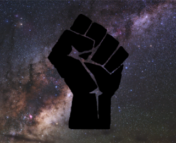Stephane Werner is a PhD student at the University of Nottingham in the UK. She is interested in galaxy formation and evolution — more specifically, she is trying to understand how galaxy clusters (a structure that consists of several galaxies bound together by gravity) formed. Originally from Rio De Janeiro, Brazil, Stephane gained an interest in science when she was a kid: “I was lucky to have very good science teachers who instigated my curiosity. My parents also gave me books about the planets and stars when I was younger, which made me interested in astronomy.” Since then, Stephane decided she wanted to be an astronomer.
Work on Galaxy Clusters
Stephane started her astronomy career at the Federal University of Rio De Janeiro (UFRJ), where she did her undergraduate education and began working on galaxy clusters: “I tried many research projects in my undergrad, which I think is a good thing. I thought I liked theoretical cosmology, because I really like math, but I ended up enjoying working with real data from galaxy clusters.” For her undergraduate thesis project, she used simulations combined with observational data to estimate the masses of galaxy clusters.
She then completed her master’s at the University of São Paulo, which has the biggest Astronomy department in Latin America. During her master’s degree, she worked on building a catalog of galaxy clusters: “before cataloging these clusters, we first needed to find them. We had this survey called S-PLUS, led by P.I. Claudia Mendes De Oliveira, a Brazilian astronomer.” Dr. Mendes de Oliveira was Stephane’s advisor during her masters, and the S-PLUS survey searched for galaxy clusters in the Southern Hemisphere.
Now, for her Ph.D. studies in the U.K., Stephane studies how galaxy proto clusters and clusters evolve over time: “the galaxies at the center of a cluster and those at the outer region that are falling into the cluster, which are where we call the infall region, actually have different properties from each other, and from galaxies which we call ‘in the field,’ which are galaxies not connected to the cluster in any way.” Stephane’s recent paper found that most galaxies at z ~ 1 (looking back ~ 8 Gyr ago, when the Universe was only ~ 6 Gyr old!) in the infall region are really red compared to those at the center of the cluster because they lost their gas while they were in the infall region.
When asked whether she had any accomplishments she was proud of, Stephane says she is just proud of how far she has come in astronomy, both in science research and outreach: “When I see my past Python code, or my past outreach posts, I see how much I’ve evolved. I changed a lot and I think that is how things are supposed to be. You learn from your mistakes of the past, and you get better. You get more mature.”
The Importance of Outreach
Ever since she was in undergraduate, Stephane has been interested in doing astronomy outreach to the general public. She taught astronomy lessons to children during her free time, and used an inflatable planetarium to teach people of all ages about the constellations and the Universe. When she started her master’s degree in São Paulo, she joined the AstroTubers project, for which astronomers would post YouTube videos about astronomy: “when you searched for astronomy on YouTube around 5 or 6 years ago, most people who posted videos about astronomy were not astronomers. This raised a concern because many of those videos were sensationalist.” The AstroTubers project contains several videos in Portuguese about astronomy and is aimed at the general Brazilian public.
When Stephane left Brazil for her PhD, she started doing science outreach by herself and with her friends. She mentions that moving to the UK was a big cultural change, and although she is there now much of her outreach focus remains on the Brazilian general public. Stephane’s Twitter account, which has over 100,000 followers, is filled with threads on recent astronomy news and curiosities about astronomy. Her YouTube channel, where she posts about life as an academic and about recent developments in astronomy, has 23,000 subscribers. She highlights that it is a big responsibility to deal with thousands of people on a daily basis, especially since some people treat science as an opinion and not a fact: “It is really hard to deal with hate on the internet.”
Juggling these commitments makes prioritizing outreach difficult, but she plans to be more consistent about her outreach efforts in the future. She recalls the many grateful messages she has received from Brazilians in social media, with people thanking her for all the information she makes available about how to start a career in astronomy. Stephane mentions that she does outreach because she considers it very important: “It’s not easy to do outreach in parallel with research. But science outreach is the reason I am where I am now. People who wrote all those books I read when I was a child, who presented on Discovery Channel, are the ones who made me interested in science. So I think this is really important, and that is why I do it. I want to see this change in society and help Brazilian people be interested in science and think more critically.”
Finally, Stephane urges academics to give more attention to science outreach: “There is this Carl Sagan Effect, where people think that because you do science outreach you are a less capable scientist, and that is not true at all.” She explains how science outreach can be important by mentioning Atila Iamarino, a Brazilian biologist who left academia to do science outreach. “When he left academia, many scientists commented that it was ‘such a waste’ of a good science researcher, but the truth is he saved millions of lives. When the pandemic hit, he used his social media platform to talk about fake news related to the pandemic and the importance of vaccines,” she says, “We have to show the students and the general public that you can do research and outreach and be good at both. They are not exclusive qualities. There must be a balance, but they are both important aspects of being a scientist.”
Edited by: Sahil Hedge
Featured Image Credit: NASA/ESA/STScI




